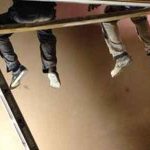Many aspects of construction can be messy jobs, and plastering is no exception. Once mixed and ready for application, plaster is wet and can drip on surfaces. It can also be a dusty job due to several factors including:
- Dust when mixing plaster powder with water.
- Once plaster is dry it can create further dust
- Cutting and shaping plasterboard
There’s no denying that plastering is typically quite a messy job. It can create a lot of dust, which needs to be removed from surfaces.
Also, because plaster is wet, it can easily drip and splatter on surfaces. This is especially the case when plastering ceilings.
What Sort of Mess Does Plastering Cause?

Plastering is a wet job. Water is required to mix the plaster, and this can lead to some spillage and splashes whilst the plaster is being mixed.
During application, when the plaster drips onto surfaces it can be difficult to remove and can leave marks.
Therefore, if you are doing this in your home, it’s important to ensure that furnishings and carpets are well-covered before beginning work. This should be done whether you are plastering yourself, or if you have hired a plasterer.
Plastering carried out in a new-build property, or a property that is under refurbishment is less of an issue. This is because the property is already a building site. There will usually be no carpets or furniture to worry about. Also, it is often much easier to clean up when work is carried out in this environment.
Plastering will also produce some dust which can settle on surfaces. This dust will need to be cleaned from doors, windows, walls, and any other surfaces when the plastering job is complete.
Is Plastering a Ceiling Messy?
As we have already discussed, plastering of any kind can be quite messy. However, when you are plastering a ceiling, it can be an especially messy job.
Plastering is hard work, and the plasterer will often drop small amounts whilst skimming a surface.
On a ceiling gravity will naturally cause the wet plaster to drip occasionally. This means that floors and any items beneath could end up with plaster splashes on them.
For this reason, homeowners should remove furniture and other items from the space before plastering begins. Even if they are in another room, you should attempt to cover them with sheets of plastic or fabric to protect from dust.
They should also ensure that any carpets are thoroughly covered up to protect them from damage.
Best Way To Clean Up After Plastering?
When it comes to cleaning up after plastering, it depends on whether you’re cleaning dust or blobs of plaster (wet or dry).
Plaster dust is relatively easy to clean up. All you need to do is dry dust the surface. This will wipe the dust particles away without making a mess of any new plaster. For other walls and surfaces, a dampened microfibre towel can also be used to clean away dust.
You may need to repeat this process several times, as it is common for plaster dust to be persistent, and it can keep resettling on surfaces. An open window can help to get rid of dust, and you should also make sure you vacuum the area thoroughly.
If wet plaster has fallen onto the floorboards this can be trickier to remove. If it is dry, you will need to use a floor scraper. However, if the plaster is still slightly damp you can scrub the surface with a small amount of water using a brush or an old towel.
Rinse out the towel in a bucket, wring it out and repeat the process. You’ll find that the bucket has a lot of plaster sludge covering the bottom once you’re done.
Should Plasterers Clean Up After Themselves?
A good plasterer should have pride in their work and cleanliness. They should reassure you before beginning work that they will leave your home in good condition.
A reputable plastering team will always cover surfaces in the areas they are working with sheets. This will ensure that cleaning up afterwards is easier and that limited mess is caused.
Good plasterers will also mix plaster in a specially designated area, or even outside. This will often be covered with plastic sheeting to ensure optimal cleanliness.
Of course, homeowners will also be expected to prepare the room before plasterers arrive.
They should remove all the fittings and furnishings before the plasterers turn up. This will help the team to have a decent area to work in. It will also minimise the mess that they could create.
Plasterers should always ensure that any plaster residue is removed from sockets, skirting boards and other surfaces.
They should also clean up any plaster dust before finishing work. If they fail to do this, homeowners are within their rights to ask them to return to put things right.
Obviously, there are always some cowboys out there, so not every plasterer will be as clean as others, however, there are reputable people out there. In the construction industry they are often well known for being a messy trade. However, providing the area is prepped correctly, you should limit the amount of cleaning up that is required.
Conclusion
Whichever way you look at it, plastering is quite a messy job.
It will be a lot easier to clean up after a plastering job on an existing building site. If the plastering is taking place in a new-build or in an extension for example, cleaning is simpler.
However, in an existing property, it can be harder to keep furnishings and floors clean. Reputable plasterers should always take all appropriate action to protect the homeowner’s property. But, homeowners should do their bit, to make sure their own belongings are protected.




